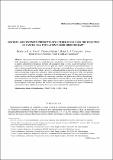Files in this item
Discrete and continuum phenotype-structured models for the evolution of cancer cell populations under chemotherapy
Item metadata
| dc.contributor.author | Stace, Rebecca E. A. | |
| dc.contributor.author | Stiehl, Thomas | |
| dc.contributor.author | Chaplain, Mark A. J. | |
| dc.contributor.author | Marciniak-Czochra, Anna | |
| dc.contributor.author | Lorenzi, Tommaso | |
| dc.date.accessioned | 2020-03-25T16:30:01Z | |
| dc.date.available | 2020-03-25T16:30:01Z | |
| dc.date.issued | 2020 | |
| dc.identifier | 259389522 | |
| dc.identifier | 5966d364-10fb-4ce2-8d89-794934d97897 | |
| dc.identifier | 000521977900008 | |
| dc.identifier | 85086564545 | |
| dc.identifier.citation | Stace , R E A , Stiehl , T , Chaplain , M A J , Marciniak-Czochra , A & Lorenzi , T 2020 , ' Discrete and continuum phenotype-structured models for the evolution of cancer cell populations under chemotherapy ' , Mathematical Modelling of Natural Phenomena , vol. 15 , 14 . https://doi.org/10.1051/mmnp/2019027 | en |
| dc.identifier.issn | 0973-5348 | |
| dc.identifier.other | ORCID: /0000-0001-5727-2160/work/71221596 | |
| dc.identifier.uri | https://hdl.handle.net/10023/19709 | |
| dc.description | Funding: German Research Foundation DFG (SFB 873; subproject B08) (T.S. and A.M.-C); Heidelberg Graduate School (T.L.). | en |
| dc.description.abstract | We present a stochastic individual-based model for the phenotypic evolution of cancer cell populations under chemotherapy. In particular, we consider the case of combination cancer therapy whereby a chemotherapeutic agent is administered as the primary treatment and an epigenetic drug is used as an adjuvant treatment. The cell population is structured by the expression level of a gene that controls cell proliferation and chemoresistance. In order to obtain an analytical description of evolutionary dynamics, we formally derive a deterministic continuum counterpart of this discrete model, which is given by a nonlocal parabolic equation for the cell population density function. Integrating computational simulations of the individual-based model with analysis of the corresponding continuum model, we perform a complete exploration of the model parameter space. We show that harsher environmental conditions and higher probabilities of spontaneous epimutation can lead to more effective chemotherapy, and we demonstrate the existence of an inverse relationship between the efficacy of the epigenetic drug and the probability of spontaneous epimutation. Taken together, the outcomes of the model provide theoretical ground for the development of anticancer protocols that use lower concentrations of chemotherapeutic agents in combination with epigenetic drugs capable of promoting the re-expression of epigenetically regulated genes. | |
| dc.format.extent | 22 | |
| dc.format.extent | 1511256 | |
| dc.language.iso | eng | |
| dc.relation.ispartof | Mathematical Modelling of Natural Phenomena | en |
| dc.subject | Cancer cell populations | en |
| dc.subject | Chemotherapy | en |
| dc.subject | Epigenetic drugs | en |
| dc.subject | Individual-based models | en |
| dc.subject | Nonlocal parabolic equations | en |
| dc.subject | QA Mathematics | en |
| dc.subject | QH301 Biology | en |
| dc.subject | RC0254 Neoplasms. Tumors. Oncology (including Cancer) | en |
| dc.subject | RM Therapeutics. Pharmacology | en |
| dc.subject | T-NDAS | en |
| dc.subject | SDG 3 - Good Health and Well-being | en |
| dc.subject.lcc | QA | en |
| dc.subject.lcc | QH301 | en |
| dc.subject.lcc | RC0254 | en |
| dc.subject.lcc | RM | en |
| dc.title | Discrete and continuum phenotype-structured models for the evolution of cancer cell populations under chemotherapy | en |
| dc.type | Journal article | en |
| dc.contributor.institution | University of St Andrews. School of Mathematics and Statistics | en |
| dc.contributor.institution | University of St Andrews. Applied Mathematics | en |
| dc.identifier.doi | 10.1051/mmnp/2019027 | |
| dc.description.status | Peer reviewed | en |
| dc.date.embargoedUntil | 2020-03-12 |
This item appears in the following Collection(s)
Items in the St Andrews Research Repository are protected by copyright, with all rights reserved, unless otherwise indicated.

